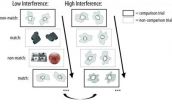Meteorite delivers Martian secrets to University of Alberta researcher
2012-10-12
(Press-News.org)
(Edmonton) A meteorite that landed in the Moroccan desert 14 months ago is providing more information about Mars, the planet where it originated.
University of Alberta researcher Chris Herd helped in the study of the Tissint meteorite, in which traces of Mars' unique atmosphere are trapped.
"Our team matched traces of gases found inside the Tissint meteorite with samples of Mars' atmosphere collected in 1976 by Viking, NASA's Mars lander mission," said Herd.
Herd explained that 600 million years ago the meteorite started out as a fairly typical volcanic rock on the surface of Mars when it was launched off the planet by the impact of an asteroid.
"At the instant of that impact with Mars, a shock wave shot through the rock," said Herd. "Cracks and fissures within the rock were sealed instantly by the heat, trapping components of Mars' atmosphere inside, and forming black, glassy spots."
The team estimates that for a period between 700,000 and one million years the rock floated through outer space until July, 2011 when it streaked through Earth's atmosphere landing in Morocco.
This is only the fifth time a Martian meteorite landing was witnessed. Herd says the fact that it was picked up just a few months after landing and was not subjected to weathering or contamination on this planet is the key reason why this meteorite is so important.
The Martian weathering involved water, which means water was present on the surface of Mars within the past few hundred million years. But Herd says this meteorite sample does not carry any evidence the water supported any life forms.
"Because the Martian rock was subject to such intense heat any water borne microbial life forms that may have existed deep within cracks of the rock would have been destroyed," said Herd.
Curiosity, NASA's current Mars Rover mission is moving around the Red Planet searching for more information on the history of Mars.
The team's study makes a return mission to Mars that will bring rocks back to Earth all the more crucial, "Martian rocks delivered to Earth by a space craft would provide the best opportunity to see if life was ever clinging to the surface of Mars."
###
A multi-national team worked on the Tissint meteorite research. Joining Herd from the U of A's department of Earth and Atmospheric Sciences was geochemistry technician Guangcheng Chen. John Duke, director of the U of A's SLOWPOKE Nuclear Reactor Facility was also a co-author of the research paper published online Oct.11 in the journal Science.
ELSE PRESS RELEASES FROM THIS DATE:
2012-10-12
Fly eyes have the fastest visual responses in the animal kingdom, but how they achieve this has long been an enigma. A new study shows that their rapid vision may be a result of their photoreceptors - specialised cells found in the retina - physically contracting in response to light. The mechanical force then generates electrical responses that are sent to the brain much faster than, for example, in our own eyes, where responses are generated using traditional chemical messengers. The study was published today, 12 October, in the journal Science.
It had been thought ...
2012-10-12
At very low temperatures, close to absolute zero, chemical reactions may proceed at a much higher rate than classical chemistry says they should – because in this extreme chill, quantum effects enter the picture. A Weizmann Institute team has now confirmed this experimentally; their results would not only provide insight into processes in the intriguing quantum world in which particles act as waves, it might explain how chemical reactions occur in the vast frigid regions of interstellar space.
Long-standing predictions are that quantum effects should allow the formation ...
2012-10-12
VALHALLA, October 11, 2012—A New York Medical College developmental biologist whose life's work has supported the theory of evolution has developed a concept that dramatically alters one of its basic assumptions—that survival is based on a change's functional advantage if it is to persist. Stuart A. Newman, Ph.D., professor of cell biology and anatomy, offers an alternative model in proposing that the origination of the structural motifs of animal form were actually predictable and relatively sudden, with abrupt morphological transformations favored during the early period ...
2012-10-12
TORONTO, ON – Psychologists at the University of Toronto and the Georgia Institute of Technology – commonly known as Georgia Tech – have shown that an individual's inability to recognize once-familiar faces and objects may have as much to do with difficulty perceiving their distinct features as it does with the capacity to recall from memory.
A study published in the October issue of Hippocampus suggests that memory impairments for people diagnosed with early stage Alzheimer's disease may in part be due to problems with determining the differences between similar objects. ...
2012-10-12
WESTMINSTER, CO (October 10, 2012)—One of life's certainties is that everyone ages. However, it's also certain that not everyone ages at the same rate. According to recent research being presented this week, the cardiovascular system of people with type 2 diabetes shows signs of aging significantly earlier than those without the disease. However, exercise can help to slow down this premature aging, bringing the aging of type 2 diabetes patients' cardiovascular systems closer to that of people without the disease, says researcher Amy Huebschmann of the University of Colorado ...
2012-10-12
WESTMINSTER, CO (October 10, 2012)—Researchers may soon be able to add yet another item to the list of exercise's well-documented health benefits: A preliminary study suggests that when cancer survivors exercise for several weeks after they finish chemotherapy, their immune systems remodel themselves to become more effective, potentially fending off future incidences of cancer. The finding may help explain why exercise can significantly reduce the chances of secondary cancers in survivors or reduce the chances of cancer altogether in people who have never had the disease.
Laura ...
2012-10-12
Parents: Want to help ensure your children turn out to be happy and socially well adjusted? Bond with them when they are infants.
That's the message from a study by the University of Iowa, which found that infants who have a close, intimate relationship with a parent are less likely to be troubled, aggressive or experience other emotional and behavioral problems when they reach school age. Surprisingly, the researchers found that a young child needs to feel particularly secure with only one parent to reap the benefits of stable emotions and behavior, and that being attached ...
2012-10-12
WESTMINSTER, CO (October 10, 2012)—Time spent in the drudgery of strenuous exercise is a well-documented turn-off for many people who want to get in better shape. In a new study, researchers show that exercisers can burn as many as 200 extra calories in as little as 2.5 minutes of concentrated effort a day—as long as they intersperse longer periods of easy recovery in a practice known as sprint interval training. The finding could make exercise more manageable for would-be fitness buffs by cramming truly intense efforts into as little as 25 minutes.
Kyle Sevits, Garrett ...
2012-10-12
Space debris came into focus last week at the International Astronautical Congress in Naples, Italy. Envisat, ESA's largest Earth observation satellite, ended its mission last spring and was a subject of major interest in the Space Debris and Legal session.
Envisat was planned and designed in 1987, a time when space debris was not considered to be a serious problem and before the existence of mitigation guidelines, established by the UN in 2007 and adopted the next year by ESA for all of its projects.
Only later, during the post-launch operational phase, did Envisat's ...
2012-10-12
BOSTON – In recent years investigators have discovered that breast tumors are influenced by more than just the cancer cells within them. A variety of noncancerous cells, which in many cases constitute the majority of the tumor mass, form what is known as the "tumor microenvironment." This sea of noncancerous cells and the products they deposit appear to play key roles in tumor pathogenesis.
Among the key accomplices in the tumor microenvironment are mesenchymal stem cells (MSCs), a group of adult progenitor cells which have been shown to help breast cancers maneuver and ...
LAST 30 PRESS RELEASES:
[Press-News.org] Meteorite delivers Martian secrets to University of Alberta researcher


